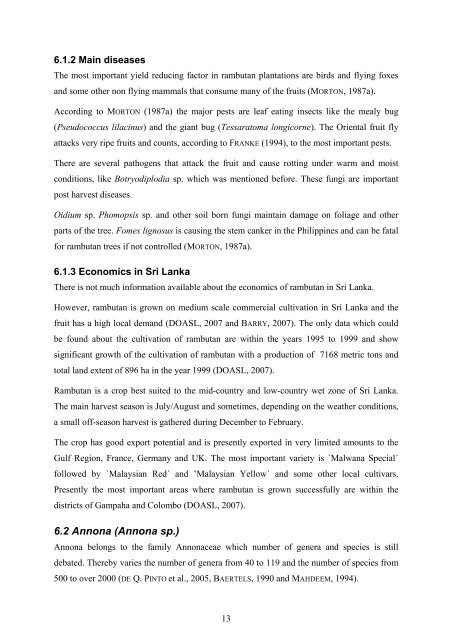Botryodiplodia sp. - Crops for the Future
Botryodiplodia sp. - Crops for the Future
Botryodiplodia sp. - Crops for the Future
You also want an ePaper? Increase the reach of your titles
YUMPU automatically turns print PDFs into web optimized ePapers that Google loves.
6.1.2 Main diseases<br />
The most important yield reducing factor in rambutan plantations are birds and flying foxes<br />
and some o<strong>the</strong>r non flying mammals that consume many of <strong>the</strong> fruits (MORTON, 1987a).<br />
According to MORTON (1987a) <strong>the</strong> major pests are leaf eating insects like <strong>the</strong> mealy bug<br />
(Pseudococcus lilacinus) and <strong>the</strong> giant bug (Tessaratoma longicorne). The Oriental fruit fly<br />
attacks very ripe fruits and counts, according to FRANKE (1994), to <strong>the</strong> most important pests.<br />
There are several pathogens that attack <strong>the</strong> fruit and cause rotting under warm and moist<br />
conditions, like <strong>Botryodiplodia</strong> <strong>sp</strong>. which was mentioned be<strong>for</strong>e. These fungi are important<br />
post harvest diseases.<br />
Oidium <strong>sp</strong>. Phomopsis <strong>sp</strong>. and o<strong>the</strong>r soil born fungi maintain damage on foliage and o<strong>the</strong>r<br />
parts of <strong>the</strong> tree. Fomes lignosus is causing <strong>the</strong> stem canker in <strong>the</strong> Philippines and can be fatal<br />
<strong>for</strong> rambutan trees if not controlled (MORTON, 1987a).<br />
6.1.3 Economics in Sri Lanka<br />
There is not much in<strong>for</strong>mation available about <strong>the</strong> economics of rambutan in Sri Lanka.<br />
However, rambutan is grown on medium scale commercial cultivation in Sri Lanka and <strong>the</strong><br />
fruit has a high local demand (DOASL, 2007 and BARRY, 2007). The only data which could<br />
be found about <strong>the</strong> cultivation of rambutan are within <strong>the</strong> years 1995 to 1999 and show<br />
significant growth of <strong>the</strong> cultivation of rambutan with a production of 7168 metric tons and<br />
total land extent of 896 ha in <strong>the</strong> year 1999 (DOASL, 2007).<br />
Rambutan is a crop best suited to <strong>the</strong> mid-country and low-country wet zone of Sri Lanka.<br />
The main harvest season is July/August and sometimes, depending on <strong>the</strong> wea<strong>the</strong>r conditions,<br />
a small off-season harvest is ga<strong>the</strong>red during December to February.<br />
The crop has good export potential and is presently exported in very limited amounts to <strong>the</strong><br />
Gulf Region, France, Germany and UK. The most important variety is `Malwana Special´<br />
followed by `Malaysian Red´ and ’Malaysian Yellow´ and some o<strong>the</strong>r local cultivars.<br />
Presently <strong>the</strong> most important areas where rambutan is grown successfully are within <strong>the</strong><br />
districts of Gampaha and Colombo (DOASL, 2007).<br />
6.2 Annona (Annona <strong>sp</strong>.)<br />
Annona belongs to <strong>the</strong> family Annonaceae which number of genera and <strong>sp</strong>ecies is still<br />
debated. Thereby varies <strong>the</strong> number of genera from 40 to 119 and <strong>the</strong> number of <strong>sp</strong>ecies from<br />
500 to over 2000 (DE Q. PINTO et al., 2005, BAERTELS, 1990 and MAHDEEM, 1994).<br />
13

















